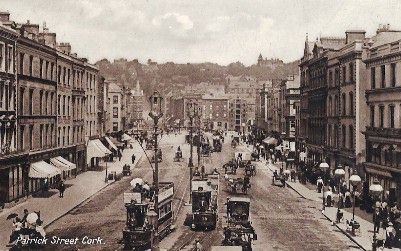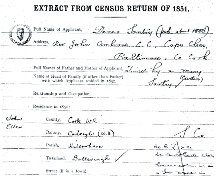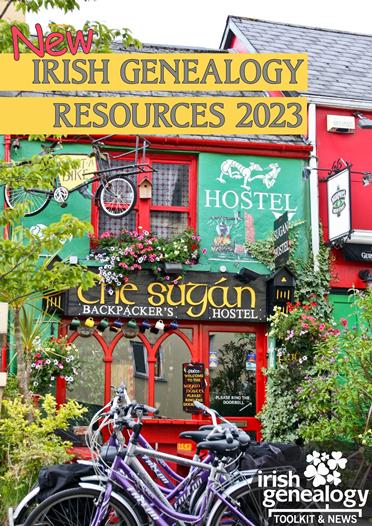- Home ›
- Irish Census ›
- Census Search Forms
Irish Pension Records –
Census Search Forms
An unlikely but useful genealogy resource
 Postcard of Patrick Street, Cork, around the time pensions were introduced in Ireland.
Postcard of Patrick Street, Cork, around the time pensions were introduced in Ireland.The Old Age Pensions Act 1908 introduced a non-contributory pension for 'eligible' people aged 70 and over. It came into law in January 1909 across England, Wales, Scotland and Ireland.
To be eligible, applicants had to have an income of less than £31 and 10shillings per annum (£31.50), and had to 'be of good character'.
Those disqualified included people in receipt of Poor Relief, institutionalised 'lunatics', and anyone with a prison record within ten years of applying.
Discretionary refusals could also be given to those who had been convicted of drunkenness or those who, while fit and able, had a history of 'habitual failure to work'.During the first three months of 1909, 261,668 applications were made in Ireland. By 31 March 1910, 180,974 Irish pensions were in force.
Poverty in Ireland
Five shillings a week
The level of benefit - not more than 5 shillings a week for a single person and 7 shillings for a married couple - had been set low for two reasons. First, to encourage people of working age to set aside sufficient funds for their own retirement. And second, to be of value to the very poorest members of society. While not overly generous, the full pension of 5/- was a useful sum. In 1909 a labourer's weekly wage was not much more than 10/-.
Ten shillings a week
Ten years after its introduction, the Old Age Pension rose to 10 shillings a week.
The Journal of the Royal Statistical Society published in December 1910 suggested that the percentage of take up among those eligibile for the Old Age Pension 'could probably be accepted as approximately indicative of the relative poverty of the population'.
The level in England and Wales was 44.7%. In Scotland it was 53.8%.
In Ireland it was 98.6%, once again demonstrating the plight of the island and central governments lack of investment in it. The pensioner with an income of less than £21 received the full pension of 5s a week. The value diminished by 1 shilling a week for every extra £2.12.6 of annual income. An income of £31.10.0 per annum meant no pension was payable.
The pension was paid on a Friday and was administered by the Post Office.
Five shillings a week
The level of benefit - not more than 5 shillings a week for a single person and 7 shillings for a married couple - had deliberately been set low for two reasons. First, to encourage people of working age to set aside sufficient funds for their own retirement. And second, to be of value to the very poorest members of society. While not overly generous, the full pension of 5/- was a useful sum. In 1909 a labourer's weekly wage was not much more than 10/-.
Ten shillings a week
Ten years after its introduction, the Old Age Pension was increased to 10 shillings a week.
The genealogical value of Irish 'pension' records
Apart from being an interesting social development and of huge importance to the elderly living in poverty, the introduction of the Old Age Pension seems, at first glance, to have little to recommend itself to the average genealogy researcher.
In England, Wales and Scotland that is probably still the case, but Ireland's situation was unique.
State registration of births did not begin until 1864 in Ireland (much later than in the rest of Great Britain), so would-be pensioners had no official documentation to prove when they were born and how old they were. A system needed to be established to substantiate such claims.
The chosen method was for a search of the 1841 and 1851 census returns (both still in existence when the Pension was introduced) for documentary evidence of the claimants age.
The claimant had to provide their parents' names and their residence in March 1841/1851 (when the censuses were taken).
Pensions Officers sent the particulars of the claimant on a Form 37 to be checked against the census for the townland or address provided to see if the claimant (many of whom were children or young adults at the time) could be discovered and his/her eligibility confirmed.
Both the 1841 and 1851 censuses were held at the Public Record Office in Dublin, where officials carried out the checks and returned their findings to the local Pensions Board.
When, as frequently happened, a search could not find the claimant, the form 37 was returned with 'not found' or 'no trace' written on it.
Pension novelty
The introduction of the pension was a huge leap in care for Ireland's elderly.
Up to 1909, what little care was provided by the state came via the Poor Relief (which carried a stigma) or the dreaded Workhouse.
Such was the pension's novelty that long queues formed outside Post Offices on the first day of payments, as families, friends and neighbours ferried their elderly into town to collect their cash, and large groups of spectators gathered to watch them do so.
In Ennis, Co Clare, the crowds and queues grew so big and excited that the police were called in to keep control.
The 'green forms'
Some people chose to directly commission (and pay) the Public Record Office to search the old censuses on their behalf. In these cases, the PRO staff filled in what are now known as 'green forms'.
The Green Forms are a completely separate collection to those mentioned above, even though they contain similar information.
The collection originally dated to 1909 but the first five years' of records were eventually pulped. However, the majority of green forms from 1915 to April 1922 survive.
How to access Irish 'pension records'
Pension novelty
The introduction of the pension was a huge leap in care for Ireland's elderly.
Up to 1909, what little care was provided by the state came via the Poor Relief (which carried a stigma) or the dreaded Workhouse.
Such was the pension's novelty that long queues formed outside Post Offices on the first day of payments, as families, friends and neighbours ferried their elderly into town to collect their cash, and large groups of spectators gathered to watch them do so.
In Ennis, Co Clare, the crowds and queues grew so big and excited that the police were called in to keep control.
1. Census Search Form 37s
Most of the Form 37s used by local pension boards are held by PRONI, in Belfast. They relate to people living in Antrim, Armagh, Cavan, Derry, Donegal, Down, Fermanagh, Monaghan and Tyrone at the time of their pension applications and include those who had been born or spent their childhood in other counties. They are also available on microfilm, courtesy of FamilySearch, in PRONI's self-service microfilm room, and their contents were published in two books by Josephine Masterson (see box in right hand column).
1. Census Search Form 37s
Most of the Form 37s used by local pension boards are held by PRONI, in Belfast. They relate to people living in Antrim, Armagh, Cavan, Derry, Donegal, Down, Fermanagh, Monaghan and Tyrone at the time of their pension applications and include those who had been born or spent their childhood in other counties. They are also available on microfilm, courtesy of FamilySearch, in PRONI's self-service microfilm room, and their contents were published in two books by Josephine Masterson.
An additional collection of Form 37s is held by the National Archives of Ireland, in Dublin, covering most of counties Cavan and Fermanagh.
2. Census Search Green Forms
The 'green forms' are also held by the National Archives of Ireland in Dublin. County-by-county indexed books are available in the Reading Room.
3. Online 'Irish pension records'
The collection of 'census search forms' held by the National Archives of Ireland has been digitised and is available free of charge on the NAI's free-to-view Genealogy website. The same records are also available free of charge on FamilySearch and FindMyPast Ireland. The collection is separate to those held by PRONI.
Fraudulent pension claims
All systems are open to abuse, and the late start to civil registration in Ireland provided the argument for many of those who chose to brazen out a fraudulent application.
However, it is worth bearing in mind that while some may have lied about their date of birth, many elderly people simply did not know exactly when they were born. It had never been particularly important before. They had a rough idea of how old they were, but nothing precise.
Even so, there is no point denying that many bogus claims were submitted.
In the year after the first pensions were paid out, some 38,495 pensions were revoked.
Related pages
If your ancestors were alive in 1911, shortly after the Irish pension was introduced, check out the Irish census page.



